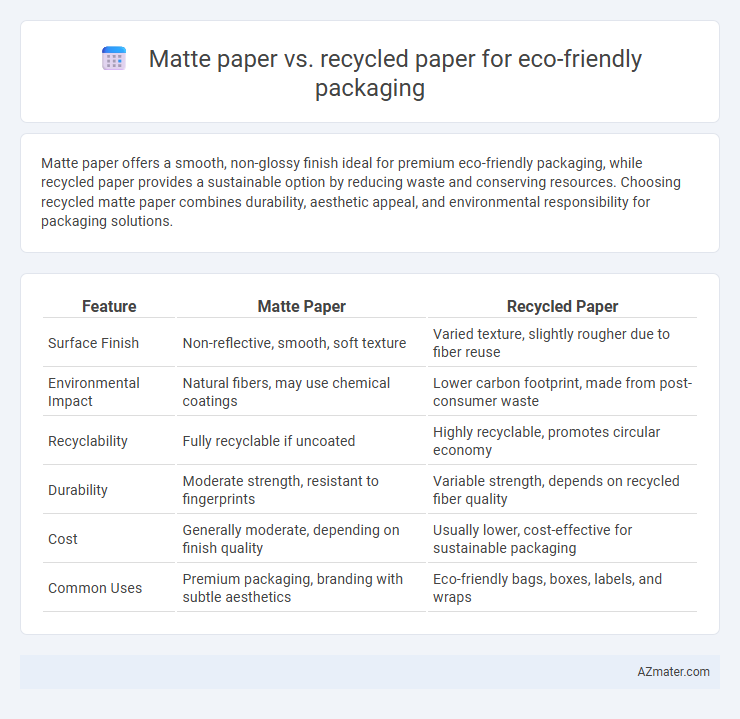Matte paper offers a smooth, non-glossy finish ideal for premium eco-friendly packaging, while recycled paper provides a sustainable option by reducing waste and conserving resources. Choosing recycled matte paper combines durability, aesthetic appeal, and environmental responsibility for packaging solutions.
Table of Comparison
| Feature | Matte Paper | Recycled Paper |
|---|---|---|
| Surface Finish | Non-reflective, smooth, soft texture | Varied texture, slightly rougher due to fiber reuse |
| Environmental Impact | Natural fibers, may use chemical coatings | Lower carbon footprint, made from post-consumer waste |
| Recyclability | Fully recyclable if uncoated | Highly recyclable, promotes circular economy |
| Durability | Moderate strength, resistant to fingerprints | Variable strength, depends on recycled fiber quality |
| Cost | Generally moderate, depending on finish quality | Usually lower, cost-effective for sustainable packaging |
| Common Uses | Premium packaging, branding with subtle aesthetics | Eco-friendly bags, boxes, labels, and wraps |
Understanding Matte Paper: An Overview
Matte paper offers a non-glossy, smooth finish that reduces glare, enhancing readability and providing a sophisticated, tactile feel ideal for eco-friendly packaging. Its composition often includes high-quality fibers and minimal coatings, making it a sustainable choice when sourced responsibly. Matte paper's subtle texture supports eco-conscious branding by emphasizing natural aesthetics without heavy chemical treatments.
What is Recycled Paper? Key Features
Recycled paper is produced from recovered fiber materials, reducing the need for virgin pulp and conserving natural resources. Key features include lower environmental impact, energy savings in manufacturing, and reduced landfill waste compared to traditional paper. This makes recycled paper a sustainable choice for eco-friendly packaging solutions that prioritize resource efficiency and waste reduction.
Manufacturing Processes: Matte vs Recycled Paper
Matte paper involves a coating process that gives it a smooth, non-glossy finish while often relying on virgin fibers, which can increase environmental impact during manufacturing. Recycled paper is produced by reprocessing used paper materials, significantly reducing energy consumption and deforestation compared to virgin fiber production. The manufacturing of recycled paper typically emits fewer greenhouse gases and uses less water, making it a more sustainable choice for eco-friendly packaging.
Environmental Impact: A Comparative Analysis
Matte paper often involves higher chemical processing and coating, which increases its environmental footprint compared to recycled paper that utilizes post-consumer waste, reducing landfill burden and conserving natural resources. Recycled paper production consumes up to 60% less energy and emits fewer greenhouse gases than virgin paper production required for matte finishes. Choosing recycled paper for eco-friendly packaging supports circular economy principles and significantly lowers carbon emissions, making it a more sustainable option over matte paper.
Aesthetics and Print Quality Differences
Matte paper offers a smooth, non-reflective surface that enhances color depth and sharpness, providing vibrant and professional print quality ideal for high-end eco-friendly packaging. Recycled paper often has a more textured, fibrous appearance that can slightly diminish print clarity but reinforces a natural, rustic aesthetic valued by environmentally conscious brands. Choosing between matte and recycled paper depends on the balance between desired visual appeal and sustainable material preferences in eco-friendly packaging design.
Durability and Performance in Packaging
Matte paper offers superior durability and resistance to wear, making it ideal for high-quality, long-lasting eco-friendly packaging that requires a premium finish and protection. Recycled paper, while environmentally beneficial due to reduced resource consumption, often has lower tensile strength and may not perform as well under heavy use or moisture exposure. Choosing between matte and recycled paper for packaging depends on balancing sustainability goals with the required durability and performance standards for the product.
Cost Considerations and Market Availability
Matte paper for eco-friendly packaging often incurs higher costs due to its specialized coating and premium finish, appealing to brands prioritizing aesthetics and tactile quality. Recycled paper provides a cost-effective alternative with broad market availability, benefiting from lower production expenses and growing demand in sustainable packaging solutions. Both materials present viable eco-friendly options, but businesses must balance budget constraints against market access and environmental impact goals.
Consumer Perceptions and Branding Potential
Matte paper offers a premium tactile experience and sophisticated aesthetic that enhances brand perception, often associated with eco-conscious luxury. Recycled paper signals environmental responsibility directly, appealing to consumers prioritizing sustainability and ethical consumption. Both materials influence branding potential by balancing eco-friendly authenticity with visual and textural appeal, shaping consumer trust and buying decisions in green packaging markets.
Certifications and Eco-labels Explained
Matte paper for eco-friendly packaging often features certifications like FSC (Forest Stewardship Council) and PEFC (Programme for the Endorsement of Forest Certification), indicating responsible forest management and sustainability. Recycled paper carries certifications such as the Recycling Association's Blue Angel or EU Ecolabel, highlighting high recycled content and reduced environmental impact. These eco-labels ensure both materials meet stringent environmental standards, aiding consumers in choosing truly sustainable packaging options.
Choosing the Best Paper for Eco-Friendly Packaging
Matte paper offers a smooth, non-glossy finish that enhances print quality and reduces glare, making it ideal for premium eco-friendly packaging designs. Recycled paper, derived from post-consumer waste, significantly lowers environmental impact by conserving resources and reducing landfill waste, often featuring natural textures that emphasize sustainability. Selecting the best paper involves balancing aesthetic preferences and eco-credentials, where matte recycled paper can provide both visual appeal and strong environmental benefits.

Infographic: Matte paper vs Recycled paper for Eco-friendly packaging
 azmater.com
azmater.com